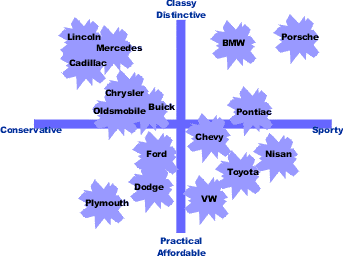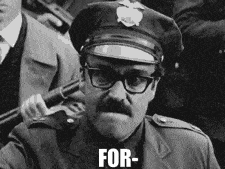How to Build a Truly Effective Consumer Profile
by Kent Lloyd • January 31, 2017
Building a consumer profile is much like the dating process. In the beginning you only get to know the surface level information about people. But just because you know about their favorite movies, that doesn’t mean you know what makes them tick.
If your marketing strategy is based on basic interactions you will be wildly misled. Why? People lie. To really profile your target market, you need to sit them down and get them talking.
It’s like dating. Sure, you can learn some interesting tidbits from someone’s Facebook profile, but until you’ve actually spent some time with them, you won’t really have a good feel for who they are.
No matter how good your data is, your marketing will never succeed if your customer profiles are only based on what you can find online.
Getting to Know Your Customers
Customer profiles based on data mining or social media profiles are inherently flawed. Why? People have a natural desire to be seen as good. As a result, most people only describe themselves the way they think will make them look good.
Let’s go back to our dating example.
If someone’s set you up on a blind date, you might check out their Facebook profile. From what you can see online, you’d probably guess that they go to the gym every day, read fantastic books every night, and eat really healthy, really expensive food.
Based on this information, if your first couple of dates go well, you might take that person on a rock climbing trip, only to discover that your date isn’t quite as fit as they said they were.
What’s the problem? You did your homework, right? The rock climbing trip should have been an ideal date!
The problem is, what’s on Facebook is mostly fiction. It’s a depiction of who your date wants to be and how he or she wants to be perceived. After all, going to the gym “every day” looks a lot better than saying, “I spend 90% of my free time binge watching Netflix.”

You run into the same problem with your consumers. The pages they’ve liked on social media aren’t actually an accurate representation of their real interests. Everyone has pity liked a page or two on Facebook just because their friend invited them to like their indie-rock band. It doesn’t mean they like indie-rock.
As a result, if you simply use Facebook’s targeting options to define your ideal audience, much of your target audience won’t really resonate with your ads.
Data mining is better, but it’s a lot like asking your blind date’s best friend about them. Yes, you’ll get more info, but you’re still only getting part of the picture. You won’t get their secret hobbies, their insecurities, or their sense of humor from any of these online forms of research, which is what you need.
It’s only after you’ve gone on multiple dates with someone that you actually get to see their real personality traits. It takes time for them to get comfortable with you. So, if you want to really profile your customers, you need to spend some face-to-face time with them.
Now don’t get me wrong, I am not saying that you shouldn’t do online data mining and secondary research. You should. It’s valuable information. You simply need to know its limits.
But, spending an hour talking to or observing another human being will be more valuable than spending even a month doing online research and reviewing stats from the latest report.
That being said, this is marketing. You can’t have a face-to-face meeting with every customer on the block. Nobody has time for that. But, if you approach it right, you can get the insights you need from a few in-person interviews.
1) Incentivize people
Food is great. Everybody loves food. What’s more, people naturally relax when they’re eating.
Making food a part of your interview process will take a lot of the pressure off of your interviewees. So, offer them dinner or snacks! As their hands go up to stuff their faces their social walls will come down. Everyone becomes more of themselves when they eat.
Food is not the only incentive that you can use to incentivize your consumers. You can also use gift cards, movie tickets, prizes, giveaways, etc.
For example, a few months back, I was building a customer profile for a client who wanted to target 13-18 year old males. Try as I might, it was like pulling teeth to get youth to take a survey less than ten minutes long.
I worked for a month-and-a-half just to get a statistically significant number respondents, but as soon as I promised $5 pizza from Little Caesar’s these teenagers became my market insight piggy bank.
2) Use perception maps
You may already be familiar with perception maps without even realizing it. They look like this.

Perception maps are great because they force your interviewees to put a concrete value or rating on what they feel. You can use that concrete rating to determine what really matters to your target audience.
While you are talking to a consumer about your company, having them fill out a couple of perception maps can give you physical data that you can compare to other responses. This method is a great technique to use in a focus group or survey, especially if your interviewees don’t know what your priorities are.
For example, if you are doing research for a fast food chain it might be good to label one axis as going from cheap to over priced, and the other axis as fattening to healthy. It doesn’t really matter what you name the axises, so long as the information you are asking for is truly relevant to your business.
If you are unhappy with how your interviewees place things on their maps, it’s probably time to take a hard look at things. If what you’re trying to sell doesn’t match up with what your customers value, you’ll need to take action. You may need to change something about the company…or you might need to run a branding campaign to change public opinion.
Either way, if your interviewees don’t prioritize things the way you expect, something needs to change.
3) Climb the ladder
Three year olds are especially good at figuring out the core motivations of adults. They might be young, but they understand a key interrogation technique called “laddering.”
Essentially, laddering is just asking “why” over…and over…and over…and over again until you get at what really motivates people.

Every time you ask “why,” it’s like creating another rung on a ladder to find out what’s at the top. You can’t climb to the top of a ladder by skipping multiple rungs. At least not unless you want to risk falling down. So, if you don’t want to risk reaching the wrong conclusions about your target audience, you have to take your time and climb each rung of information in order.
To illustrate how this works, let me show you a conversation that I once had with a friend of mine concerning Christmas letters that families share (a tradition that I have never really understood).
ME: “Do you write your own Christmas newsletters?”
COURTNEY: “I do.”
ME: “Why?” (here’s the first rung of my ladder)
COURTNEY: “I enjoy it. It’s a good way to reflect on the past year and see what I’ve accomplished.”
Most surveys and interviews would normally stop here, at the first rung. This is where the majority of bad ads come from. Marketers take the easy answer and just move onto the next question on their list. If you want your ads to be hitting the sweet spot of your brand insight combined with the consumer insight, then you’ll press on.
ME: “Why do you want to reflect on your past year?” (second rung)
COURTNEY: “Because it makes me feel good realizing what I’ve been able to totally dominate or fail at in the last year. It’s like taking an inventory of my life.”
I could’ve stopped here, but I could tell there was something more. She had just basically restated what she said in the first place.
ME: “Why is that important to you?” (third rung)
COURTNEY: “Because it helps me know what I can do to be better next year?”
She was hesitant at this point. That’s a good sign. You want people to hesitate because it means they are actually thinking past their own preconceived ideas. If the person you’re interviewing never hesitates, you’re not going deep enough.
ME: “Why is being better next year important?” (4th rung)
COURTNEY: “Because… I have two little girls that look up to me and I need to be the best I can be for them.”
Now that’s deeper thinking. Courtney felt pressure to be a good parent. But who or what was putting that pressure on her?
ME: “Why is being better for your kids important?” (5th rung)
COURTNEY: “Because if I don’t then they may blame me later on in life for how they turned out.”
That seems rather specific. And it begged the question, why was that Courtney’s fear? So, I asked the question.
ME: “Why would that matter to you?” (6th rung)
COURTNEY: “Because I don’t want to end up like my mom.”
There’s your core insight. At least that was Courtney’s core insight. But this still wasn’t my core insight. This could be something that only Courtney thinks is important, or it could apply to a lot of people. There was only one way to find out.
ME: “What do you mean by that?” (7th rung)
COURTNEY: “My mom doesn’t really have contact with me and my siblings because of a bunch of things that she did while we were growing up. It messed with a lot of our heads. We talk to her on her birthday but that’s about it.”
Again, this was pretty specific to her life experience. Not many other people will have that experience. I needed her to connect all of this in more of a broad sense to writing christmas letters. So, I started directing my “why” questions back to their original source.
ME: “So, why is having a better relationship with your kids important?” (8th rung)
COURTNEY: “Because I love my kids.”
She teared up at this point. I could tell what she was getting at, but to ensure that I wasn’t injecting my own opinion, I needed her to make the connection in her own words.
ME: “So what does that have to do with Christmas letters?” (9th rung)
COURTNEY: “I guess… It’s my proof to the world that I’m better than my mom.”
BOOM! That’s the money maker right there. For Courtney, this was a core motivation that would sell.
Of course, I probably wouldn’t make an ad campaign that said, “Prove to the world you’re better than your mom, buy our cards!” but I could use that underlying motivation to craft a very compelling campaign….provided that most Christmas-card sending moms had the same motivation.
Now, I’m not in the business of selling Christmas cards, so I don’t know if this is a common motivation or not, but do you see the journey that Courtney went on?
Courtney went from saying that she felt a sense of accomplishment from writing Christmas letters to needing to prove that she’s better than someone else. You will never get that kind of a response from a survey, because no one will let themselves come off as that conceded on a first impression.
A Few Tips on Effective Laddering
Laddering is an incredibly powerful technique, but it does come with a warning label: DO NOT use laddering without telling your consumer what you’re going to do first. Like the three year old, if you ladder without preparing your consumer for it, they can become frustrated with your questions.
One question that I frequently get asked about laddering is, “How do you know when it’s done? How can you know when you’ve gone deep enough?”
You literally could keep asking “why” forever!

My professors back in college used to say that you’d know your laddering is done when the consumer started crying. But the real answer is: you will feel it.
Be sensitive to their emotions and don’t use laddering for too long in your interview. I personally only ever use it for 2-3 questions out of an interview. But, I know others who only use it for 1-2 questions.
The ultimate goal here is to discover at a deep level where your customer is coming from. Once you identify their true motivations, you can use that information to come up with an incredibly compelling advertising message.
For more information on other research methods check out “The Practical Pocket Guide to Account Planning.”
Conclusion
Most internet advertising strategies are like most social media stalkers, they know their audience well enough to be creepy, but not well enough to get someone to commit. There are so many ads out there that only go skin deep. Those ads make people think “that was cool,” but they doesn’t make them think “that company gets me, I need their stuff.”
“That company gets me” is exactly what you want and need if you want your marketing to be effective. You can only get those sorts of insights by sitting down and actually talking to your target audience.
So, if you want to run amazingly effective marketing campaigns, talk to your potential and current customers. Use the techniques we’ve discussed to really get to know them and then use what you learn to create campaigns that target your real audience’s real motivations.
Your ads will thank me later.





